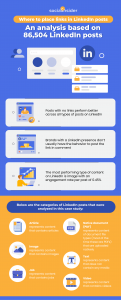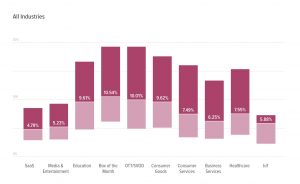
Empathy is an emotion that many marketers invoke when they are developing their positioning and messaging for various campaigns. They consider questions such as: “If I put myself in the buyers’ shoes, what do I think they think or feel about this particular pain point?” “Do I understand the challenges they are facing?” “How can I help them overcome this issue and provide long-term value?”
Over the last few years, many B2B marketers have leveraged account-based marketing (ABM) to address these questions with specific use cases and examples tailored to their target accounts, in order to boost engagement and drive high-value conversions.
However, in a time when COVID-19 is ravaging communities all over the world, standard ABM approaches should be examined and adapted – especially since the needs of your prospects and customers are probably changing (and rather quickly) as a result of the pandemic.
The reality is, while most are trying to move forward as best as they can given these unprecedented circumstances, it’s important to acknowledge that business is not operating as usual. Everyone’s lives have been disrupted, at both a business and personal level.
With this in mind, how can marketers effectively cater to the needs of their customers and prospects who are actively looking for solutions during this period of uncertainty, while maintaining the sensitivity of the situation at hand? It’s important, of course, to maintain empathy and adjust your approach.
Re-evaluate Your Target List
A while back, I wrote a two-part blog series called “Building an ABM Framework: The 5 P’s to Success.” In Part 1, I shared that the first step is to Prioritize, which refers to the process of developing your ideal customer profile (ICP) and your target account list.
One unfortunate reality of a global pandemic is that some industries are suffering because of it, while others are actually thriving. That’s why, depending on the volume and scope of your ABM program, it may be a good time to re-evaluate and re-prioritize your target list. While prioritization is always meant to be an iterative process with your sales team, times like this should be an impetus to revisit your list, based on how the market is behaving. Many of our clients who normally re-evaluate their target lists on a quarterly or semi-annual basis are using the time now to do this, paying special attention to – and realigning based on – market performance.
During your review process, make sure to look for accounts or industries that align to your ideal customer profile that aren’t currently on your ABM list, and ask yourself: could they benefit from your product or service right now? If so, I’d encourage you to incorporate these accounts into your program in the place of those accounts that you know are struggling at this time.
If you are actively marketing to accounts in a negatively impacted industry, it might make sense to remove them from your program, at least in the short term. If it’s a priority and necessity to market to that industry, consider how you are currently speaking to them. Are you acknowledging the current situation? Are you providing resources to address their current obstacles? If not, you may not be providing the most appropriate experience to those accounts and buyers.
Engage with Relevance and Empathy
At Evergage, we say the core of the word personalization is person. Each person deserves to be given a relevant, individualized experience based on their unique interests and needs.
This is a time when understanding what your prospects and customers need is of the utmost importance. Buyers, more than ever, are going to be taking particular note of the types of experiences they are receiving. You do not want to appear tone-deaf or overly promotional, plugging various content and products that don’t make sense or won’t come across well given the current circumstances. To ensure that this doesn’t occur, you may want to loop in additional teammates or colleagues during your review cycle for extra scrutiny. Having additional perspectives will help you identify areas where you are potentially missing the mark with your target audience.
At this time, too, it’s absolutely critical to engage your target audiences with relevance and empathy. You want to help your customers and prospects find the resources they need in the most efficient way possible. With personalization, you can easily identify visitors from target industries or accounts the moment they land on your website, and deliver 1-to1 experiences, content and calls-to-action based on their needs and behavior.
You also don’t need to rely on IP addresses alone for account and industry identification. By understanding each visitor’s interests and intent, you can automatically tailor each experience to improve engagement and deliver relevant content.
Even more importantly, when someone engages with your website or app, think about what you are saying to them. If a lead converts, how is your sales team speaking to them? In both cases, you should be extremely cognizant of and thoughtful about the impact of the coronavirus, and think about how this influences your response. This doesn’t mean it needs to be the total focus of your conversation; it just means that you should be extremely considerate of what is appropriate in the context of the situation.
Many of our clients (and other companies, at large) are leading with messages of reassurance from their CEOs on their sites – expressing genuine concern for their customers’ well-being, detailing (often fluid) business plans and explaining steps they’re taking to help their customers, and the wider community, during the crisis. Many also are publishing thoughtful blog posts or creating generous offers about business resources that companies can take advantage of to help them in meaningful ways.
For example, Quick Base and Brainshark are currently presenting these valuable offers on their sites:


Final Thoughts
Ultimately, while re-evaluating your target lists and applying personalization are two effective strategies for improving both your ABM program and your customer experiences, there is still more to be done. What we are currently experiencing is nothing like we’ve ever seen before, and it’s important to remember that everyone is coping differently under these difficult circumstances. Showing compassion to your prospects and customers while we all navigate these uncharted waters together is going to be one of the key ways to build and strengthen customer relationships, and help buyers get what they need.
Business & Finance Articles on Business 2 Community
(47)
Report Post







